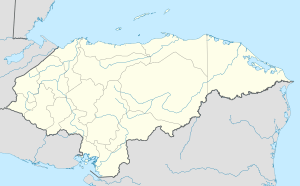Concepción, Intibucá facts for kids
Quick facts for kids
Concepción
|
|
|---|---|
|
Municipality
|
|
| Country | |
| Department | Intibucá |
| Municipality | Concepción |
| Guarajambala | 1759 |
| Concepción | 1867 |
| Government | |
| • Type | Democratic Municipality |
| Area | |
| • Total | 91.82 km2 (35.45 sq mi) |
| Elevation | 495 m (1,624 ft) |
| Population
(2015)
|
|
| • Total | 10,209 |
| • Density | 111.185/km2 (287.968/sq mi) |
| Time zone | UTC-6 (Central America) |
| Postal code |
14000
|
| Municipality number | 1004 |
Concepción is a town and a "municipality" (like a local government area) in the Intibucá Department of Honduras. It's a place with a rich history and beautiful natural surroundings.
History of Concepción
Early Beginnings
A long time ago, in 1582, this area was called Guaraxambala. This name meant "Great Jaguar River." The first people to live here were the Lenca, who are an indigenous group from this region.
Spanish settlers later came to the area. They set up farms called ejidos. These farms were started by important local leaders.
Becoming a Municipality
Concepción officially became a municipality in 1759. At that time, it was still known as "Guarajambala." Two years later, the Spanish government in Guatemala made it part of the Camasca region.
In 1867, the municipality's name was changed to Zepeda y Zepeda. But this name didn't last long!
The Name Concepción
On February 23, 1904, the president of Honduras, General Manuel Bonilla, changed the name again. He officially named the municipality "Concepción." It was also moved into the Intibucá Department.
This change happened because of a special law. The town was named after its patron saint, the Virgin of Concepción.
Geography of Concepción
Where is Concepción?
Concepción covers an area of about 91.82 square kilometers (about 35.45 square miles). It is located at 14.03 degrees north latitude and 88.34 degrees west longitude.
The municipality has neighbors all around it:
- To the north: San Marco de Sierra
- To the south and east: Colomoncagua
- To the west: Camasca and San Francisco
Roads and Travel
A main road connects Concepción to La Esperanza, which is the capital city of the department. This road is about 51.7 kilometers (32.1 miles) long. Parts of it are paved, and parts are gravel. It's usually easy to travel on.
Other roads go southwest to Camasca and Magdalena. There are also roads southeast to Colomoncagua. Smaller roads connect to the villages around Concepción. These smaller roads are mostly good during the dry season. During the rainy season, some of them can become difficult to use.
The Land Around Concepción
The area around Concepción is not flat. It has many hills. The town itself is on a gentle slope that goes from north to south, down to the Río Negro (Black River). The average height of the municipality is about 495 meters (1,624 feet) above sea level.
Water Resources
Important Rivers
Concepción has several important rivers. The biggest is Río Negro. There are also three smaller rivers: San Juan, Santiago, and San Jerónimo. All these smaller rivers flow into the Río Negro.
Río Negro is also called Guarajambala by local people. It forms the southern border of the municipality. This river starts in the mountains of Colomoncagua and Santa Elena. It eventually flows into the Lempa River, which then goes into the Pacific Ocean.
How People Use the Rivers
People in Concepción use Río Negro for different things:
- Fishing: They catch fish using traditional methods.
- Sand and Gravel: They collect sand and gravel from the riverbed.
- Tourism: It's a nice place for people to visit and relax.
The San Juan River separates Concepción from San Francisco, Lempira. It's also used for fishing and as a source of sand. The Santiago River creates a small grassy area, which is good for farm animals to graze. It's also used for small farms and for collecting sand. The San Jerónimo River is used for fishing.
Water for Communities
There are 26 communities in Concepción that have access to water. However, only 21 of these communities have water all year round. Sixteen communities get their water from one of the four rivers. Four communities only have water during the rainy season.
Climate
Weather in Concepción
Concepción has a warm, "semitropical" climate. This means it's usually warm all year. The average temperature is between 23°C (73°F) and 25°C (77°F).
Rain and Dry Seasons
The municipality gets a lot of rain, usually between 2000 mm and 3000 mm (about 79 to 118 inches) each year. The rainiest months are from June to September. The dry months, which locals call "summer," are from January to April.
During the dry season, strong winds blow from the northeast to the southeast. These winds can dry out the soil, sometimes cause power outages, and affect crops and people's health.
Population
How Many People Live Here?
Concepción has about 10,605 people living in it. Out of these, 5,272 are boys or men, and 5,333 are girls or women.
Most of the people are young:
- 5,530 people (52.1%) are 17 years old or younger.
- 4,480 people (42.2%) are between 18 and 64 years old.
- 595 people (5.6%) are 65 years old or older.
The population density is about 115.5 people for every square kilometer. This means the area is not too crowded.
Different Backgrounds
A census from 2013 showed the different groups of people living in Concepción:
- About 57.68% are Mestizo, which means they have mixed European and indigenous backgrounds.
- About 33.96% are Indigenous, mostly from the Lenca group.
- About 7.55% are White.
- About 0.80% are Afro-Honduran or Black.
See also
 In Spanish: Concepción (Honduras) para niños
In Spanish: Concepción (Honduras) para niños


